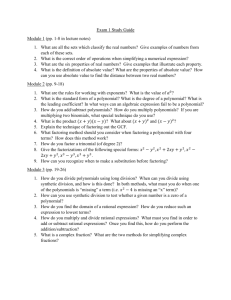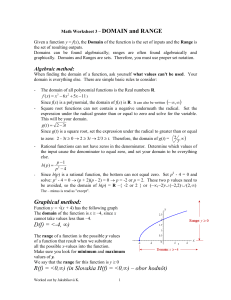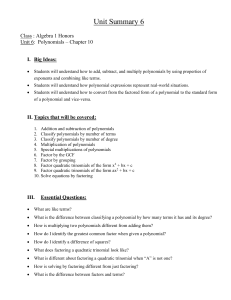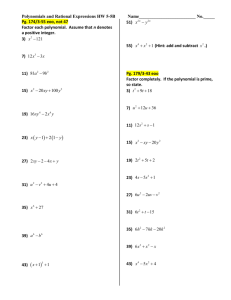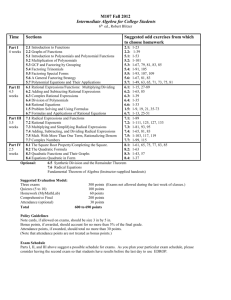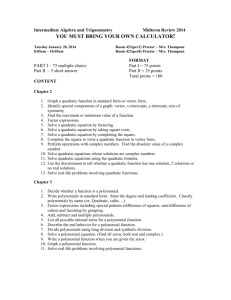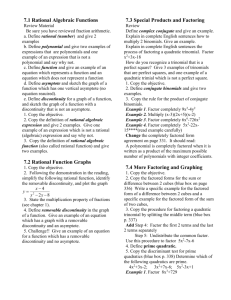PSP Calc Outlines & assignments
advertisement
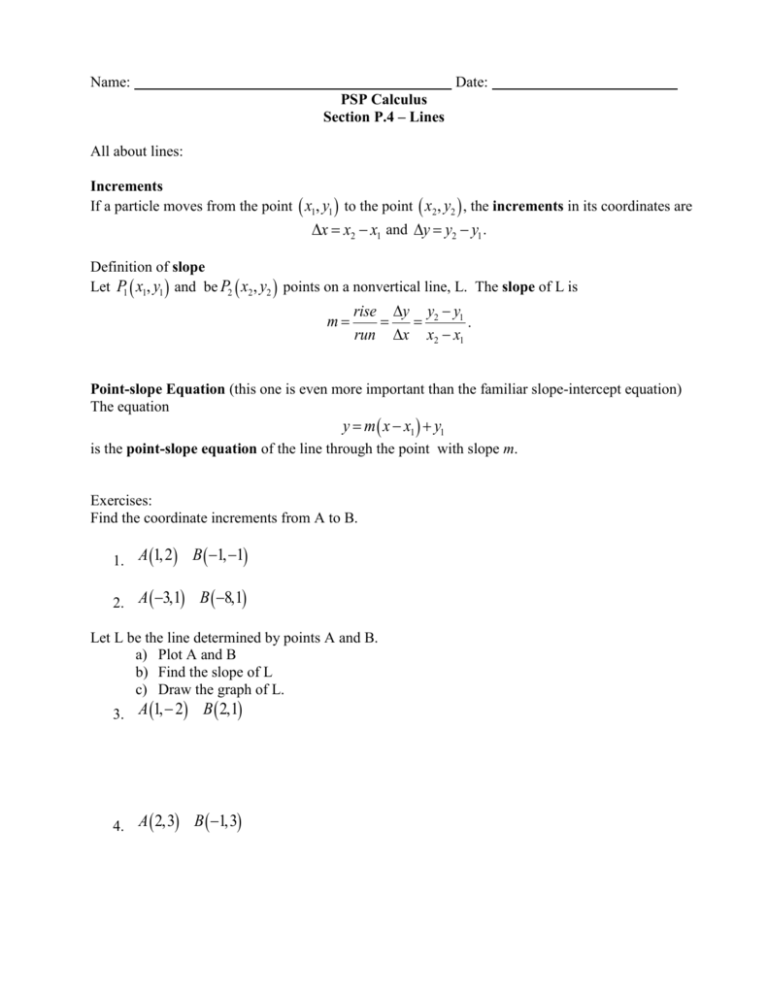
Name: Date: PSP Calculus Section P.4 – Lines All about lines: Increments If a particle moves from the point ( x1, y1 ) to the point ( x2 , y2 ) , the increments in its coordinates are Dx = x2 - x1 and Dy = y2 - y1 . Definition of slope Let P1 ( x1, y1 ) and be P2 ( x2 , y2 ) points on a nonvertical line, L. The slope of L is m= rise Dy y2 - y1 = = . run Dx x2 - x1 Point-slope Equation (this one is even more important than the familiar slope-intercept equation) The equation y = m ( x - x1 ) + y1 is the point-slope equation of the line through the point with slope m. Exercises: Find the coordinate increments from A to B. 1. A (1, 2) B ( -1,-1) 2. A ( -3,1) B ( -8,1) Let L be the line determined by points A and B. a) Plot A and B b) Find the slope of L c) Draw the graph of L. 3. A (1,- 2) B ( 2,1) 4. A ( 2,3) B ( -1,3) Write an equation for (a) the vertical line and (b) the horizontal line through the point P. 5. P ( 2,3) ( 6. P 0,- 2 ) Write the point-slope equation for the line through the point P with slope m. 7. P ( 2,3) m = 4 8. P ( 0,3) m = 2 9. P ( -1, 1) m = -1 Write an equation for the line through P that is (a) parallel to L, (b) perpendicular to L. 10. P ( 0, 0) L : y = -x + 2 11. P ( -2, 2) L : 2x + y = 4 12. P ( -2, 4) æ è 1ö 2ø L:x=5 13. P ç -1, ÷ L : y = 3 PSP Calculus Appendix A.1 – Radicals and Rational Exponents OUTLINE Pg. 839 – 843 Define each term and give an example for each term (p. 839): square root: cube root: Define each term: nth root: principal nth root: Example: 35 243 What is the principal 5th root of 243? radical expression: index: radicand: Write this fact using a radical expression: Real and Principal Roots Summarize the differences when finding or identifying the nth roots when n is even compared to when n is odd (p. 839). If there is no index in a radical expression, what assumption can we make? EXAMPLES (work out each sample problem): a) 121 b) 4 81 256 c) 5 32 d) 6 1 64 Properties of Radicals (p. 840) In the table below, write out the 6 properties of radicals and complete each example so that it illustrates the property given. Property Example 1. 80 16 5 = 2. 3 125 27 3 3 = 3. 5 4. 5. 4 813 6. 4 124 3 123 9 11 = 16 9 In each property, u and v represent: m and n represent: BE VERY CAREFUL! What is the difference between property 4 and property 6? Simplifying Radical Expressions (pages 840, 841) EXAMPLES (work out each sample problem): a) 5 96 b) 3 1080 c) 75z 9 = d) 6 p6 = q6 e) 3 54x 9 Rationalizing Denominators (p. 841) EXAMPLES (work out each sample problem): a) 7 = 5 b) 2 c) 1 d) x = = 5 y2 4 w = 8v 3 Rational Exponents (p. 841) Explain why x 2 x : 1 Write the formal definition for Rational Exponents (p. 841): What does the numerator in a rational exponent represent? What does the denominator in a rational exponent represent? EXAMPLES (write the radical expressions using rational exponents and vice versa): 115 a) 7 b) 5 x 3 2 = c) 6a 2 4 a 3 = d) p 9 4 Summarize the procedures used to simplify radicals (p. 843): Book assignment: Pages 843 and 844 – #3-81 (multiples of 3 and 4) SHOW ALL WORK FOR THESE PROBLEMS! A LIST OF ANSWERS WITHOUT WORK WILL NOT BE ACCEPTED! Appendix A.2 Polynomials and Factoring OUTLINE Pg. 845 – 850 Adding, Subtracting, and Multiplying Polynomials Write the definitions of: Polynomial in x Degree (of a polynomial) Lead coefficient Monomial Binomial Trinomial Standard form Like terms Add the following polynomials: 3x 3 5x 2 7 x 2 2 x 3 8x 2 3x 9 Subtract the following polynomials: 2 x 3 6 x 2 11x 16 x 3 2 x 2 4 x 18 Expand each product and simplify the polynomial: a) 2x 8x 7 b) 2 x 3 2 x 2 3x 2 x 3 2 x Special Products (p. 846) Special Binomial Products: Let u and v be real numbers, variables, or algebraic expressions. 1. 2. 3. 4. 5. Using Special Products Use the special products from above to expand each product below without performing any multiplication or simplification. 2 a) 4 x 5 b) 5a 22 c) 8z 38z 3 d) 6 x 23 Factoring Polynomials Using Special Products (p. 847) What does it mean for a polynomial to be completely factored? Explain why x 4 16 x 2 4 x 2 4 is NOT a complete factorization of the polynomial x 4 16 . Factor each polynomial completely: a) 3x 3 3x 2 9 x a) a 4 b ab 4 b) 49 y 2 4 c) 36 g 2 g 5 2 d) 25d 2 30 x 9 Should be 25d 2 + 30d + 9 e) 81x 2 36 xy 2 y 2 f) x 3 27 g) 125 x 3 8 h) x 2 9 x 14 i) z 2 5 z 24 j) 14t 2 33t 15 Factor each polynomial by grouping (p. 860): x 3 4 x 2 5 x 20 x 6 3x 4 x 2 3 Steps for Factoring Polynomials (p. 860): Book assignment: P. 851 (2 – 78 even, 83, 87, 88, 90, 91) SHOW ALL WORK FOR THESE PROBLEMS! A LIST OF ANSWERS WITHOUT WORK WILL NOT BE ACCEPTED! Name: Date: PSP Calculus Section P.5 – Solving Equations Graphically, Numerically and Algebraically OUTLINE Definition: Quadratic Equation – What is the zero product (factor) property? Solve the equation graphically, and confirm by using factoring: 6x 2 7 x 5 0 Solve algebraically by extracting square roots: (3x 1) 2 16 How can any quadratic equation be written in the form of (ax b) 2 c ? Solve by completing the square: 4 x 2 20x 17 0 State the Quadratic Formula: Solve using the quadratic formula, and state the solutions in simplest form and as decimal approximations: 2 x 2 8x 5 State the four ways to solve a quadratic equation algebraically: 1. 2. 3. 4. Explain how to solve the equation graphically: x 3 x 1 0 Explain how to solve the equation using tables: x 3 x 1 0 Solve the equation algebraically, and verify by finding intersections: 2 x 5 7 Assignment: Pg. 50 #3-44 multiples of 3 and 4, 59-61
